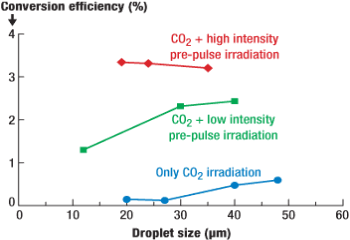March 4, 2011 — Gigaphoton released the latest developments in its EUV source program at this week’s SPIE Advanced Lithography conference. The company reported achieving a conversion efficiency (CE) of 3.3% with tin droplets <20µm in diameter (see figure) with its plasma-based laser produced plasma (LPP).
 |
|
Figure. Conversion efficiency vs. droplet size for tin plasma-based LPP EUV source. SOURCE: Gigaphoton |
 In a podcast interview at the conference, Kenji Takahisa, manager in Gigaphoton’s management planning department, explained the physics behind the performance. Listen to the interview: Download (iPhone/iPod users) or Play Now
In a podcast interview at the conference, Kenji Takahisa, manager in Gigaphoton’s management planning department, explained the physics behind the performance. Listen to the interview: Download (iPhone/iPod users) or Play Now
The key is the use of a short wavelength pre-pulse to irradiate the tin droplet. The small focus size of the pre-pulse laser penetrates the tin droplets, creating optimal conditions (i.e., an ideal "fine mist"). When the main laser irradiates the target droplet, a "perfect mist" is distributed in the focal plane of the CO2 main laser; the mist is transformed into vapor and is ionized. Any remaining debris, which is also ionized, can then be guided by a magnetic mitigation system to a tin "catcher" away from the collector mirror. Such mitigation ensures a longer life of the collector mirror. Takahisa also explains the experimental data shown in the figure in the interview.
More from SPIE Advanced Lithography 2011:
- Cymer talks EUV source timelines and DUV highlights at SPIE
- EUV, resists, multibeam lithography chat with imec
- SPIE 2011: Where are we now with EUV?
- Carl Zeiss photomask registration correction system, RegC, debuts
- Cymer focus drilling for immersion light sources improves depth of focus by 2x
- Nanometrics launches overlay metrology system, wins order from Asia
- EUV lithography vs EBDW: Interview with Toppan Photomasks at SPIE
- Synopsys lithography verification in Proteus LRC handles EUV, double patterning
- SPIE keynote: Imec installs ASML pre-production EUV scanner NXE:3100
- Brewer Science launches immersion lithography products with OptiStack
Subscribe to Solid State Technology/Advanced Packaging.
Follow Solid State Technology on Twitter.com via editors Pete Singer, twitter.com/PetesTweetsPW and Debra Vogler, twitter.com/dvogler_PV_semi.

